Choose the Right Cattle Breed for Your Farm
Welcome, Aspiring Cattle Farmers!
You’ve made the exciting decision to raise cattle – congratulations! As any experienced rancher will tell you, choosing the right cattle breed for your farm is one of the most important decisions you’ll make to set your new endeavor up for success.
With so many factors to weigh like climate, land type, facilities, and your production goals, settling on the optimal breed can feel overwhelming initially. But fear not – armed with the fundamental knowledge this guide provides on the array of breeds available and key considerations before selecting, you’ll be equipped to confidently move forward.
The vast diversity across cattle breeds means there’s truly a stock suited for every operation. Whether your sights are set on being a small beef producer, an organic dairy farmer, or even both, multiple breeds can likely fit the bill. And the rewards? Beyond a sustainable source of income, raising cattle fosters a peaceful lifestyle and deep connection to the land.
So let’s delve into the exciting world of cattle breeds, and get you set up for fruitful, prosperous years of farming ahead!
Set the Stage for Success
In your eagerness to build your herd, it’s tempting to skip straight to browsing cute cattle photos online. But seasoned farmers know some vital groundwork is required beforehand to choose viable breeds and ensure smooth sailing once animals arrive at your farm.
Define Your Goals
With an abundance of breeds specialized for different functions, your intended purpose is the most pivotal factor. Key questions to answer:
- Will you produce beef, dairy or both? Beef cattle efficiently convert grass and grain into high-quality meat, while dairy breeds channel energy towards maximum milk production. Some dual-purpose varieties excel at both.
- What production volume do you want? Certain breeds better suit small-scale hobby farms, while others require large-scale operations to realize profitability.
- Are you targeting specialty/niche markets like organic, grass-fed or aged cheese production? Some breeds naturally meet niche requirements.
Know Your Budget
Cattle aren’t a small investment, especially when factoring in land, housing and equipment. Be realistic about startup and ongoing costs:
- Purchase price: Beef calves cost $500-$2000, dairy heifers $1500-$3500.
- Infrastructure: Fencing, housing, milking parlor, machinery (if applicable)
- Feed: Costs vary widely based on climate, breed choice and feed source
- Labor: Especially for dairy, consider hired help if farm is too labor-intensive
- Vet Care: Average $300/animal/year, more for emergencies
Assess Your Resources
From climate to pasture type, facilities and labor availability, your farm’s unique conditions influence suitable cattle breeds.
- What growing zone are you in? Heat/humidity tolerance and winter hardiness varies.
- Does terrain and soil type support quality pastures/crops?
- Are there enough structures to house animals and equipment (if dairy operation?)
- Can you manage herd labor demands or need to minimize?
With clear goals set, budget defined, and strong grasp of farm’s resources in place, you’re ready to narrow breed options!

Beef versus Dairy: Key Differences
Before comparing specifics on cattle breeds, it’s helpful to understand some intrinsic differences between beef and dairy types.
Size and Growth Rate
Beef breeds are selected for efficient, fast muscle growth, reaching slaughter size quicker with higher meat yield. They tend to be larger and more muscular than dairy breeds.
Dairy breeds divert energy towards milk production rather than size. They grow leaner and slower.
Udders and Milking Ability
Top dairy breeds are bred specifically for well-attached, capacious udders and ease of milking. Beef cows produce just enough milk to nurse a calf.
Reproduction Efficiency
To be profitable, dairy cows must conceive and birth a calf annually to keep milk flowing. They reach puberty early for a longer productive life.
Most beef breeds calve later and less often without significantly impacting meat yield.
Disposition
Calm temperaments are favorable in dairy breeds for ease of handling and milking. Some beef breeds tend towards more excitable dispositions.
An Introduction to Major Breed Categories
With hundreds of breeds worldwide, it helps to understand the primary cattle categories most common breeds fall within before getting into specifics.
English Breeds
Originally from the British Isles, these medium-large framed cattle thrive on lush pasture. They are early maturing and produce high-quality beef. Examples: Angus, Hereford, Shorthorn
Continental/European Breeds
Larger, later maturing breeds giving lean, heavily muscled carcasses. Most originated in mainland Europe. Heat tolerant. Examples: Charolais, Simmental, Gelbvieh
Dual Purpose
Excel in both milk and meat production. Often originated from English or European stock. Examples: Milking Shorthorn, Brown Swiss, Red Poll
Indian Breeds
Adapted for tropical climates, these hardy breeds have loose skin and light bones for heat dissipation. Examples: Brahman, Gir, Nellore
African Breeds
Tolerant of dry conditions, parasites and diseases. Often have horns/humps for heat regulation. Examples: Ankole Watusi, Tuli
Now let’s explore specifics on several of the most popular breeds!
In-Depth on Leading Breeds
Choosing among the various breeds can feel confusing initially. But once you have your farm goals and resources in mind, you can zero in on suitable options. Let’s look closer at traits of top breeds.
1. Angus: Prime Pick for Flavorful Beef
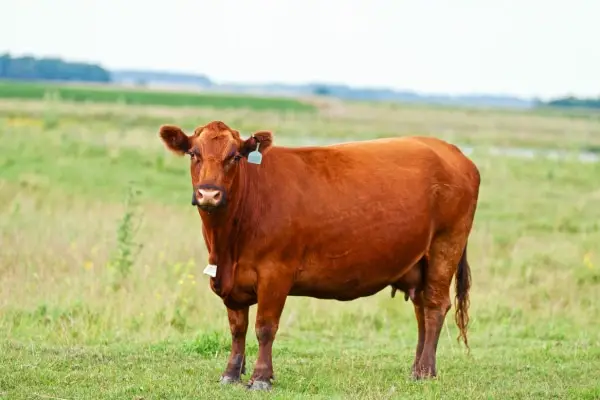
Originally from Scotland, Angus is the number one breed of cow in the US, making up over 60% of American cattle stocks. And for good reason – these cattle produce exceptionally flavorful, marbled beef earning top grades. Their popularity stems from other favorable traits too:
- Disposition: Docile, calm temperaments
- Mothering ability: Attentive, protective moms raising vigorous calves
- Calving ease: Heifers birth small calves relatively easily
- Adaptability: Thrives in diverse climates and on varied feed sources
- Hardiness: Withstands temperature extremes well
For cattle operations targeting premium beef markets – especially natural, grass-fed or organic – Angus is a prime pick. Their only downside? Below average milk production makes them unsuitable for dairies.
2. Holstein Friesian: Global Dairy Dominators
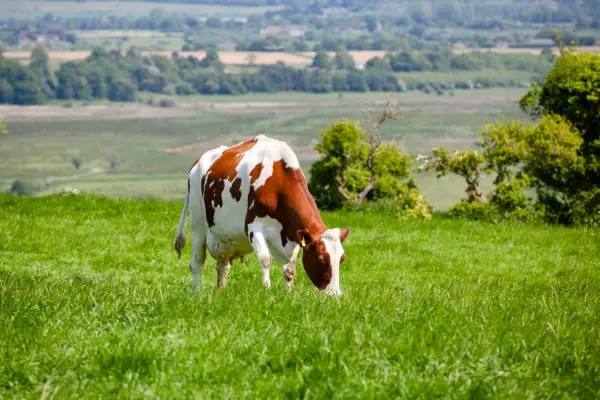
If high milk yield tops your priority list, look no further than Holstein Friesians. These black and white spotted beauties are the undisputed dairy production champs worldwide, making up 90% of US dairy herds. Success factors include:
- Peak production: At over 25 liters daily, Holsteins produce more milk than any other dairy breed
- Feed efficiency: Converts feed nutrients into milk most effectively
- Healthy udders: Ideal shape and placement for easy milking
- Fertility: Reach puberty early and breed back reliably
- Calving ease: Despite large size, birth small calves without trouble
While some criticize Holsteins for poor longevity or meat quality, their milk output can’t be beaten. For commercial dairies, they are the obvious pick. Backyard milk producers may favor smaller dual-purpose breeds.
3. Hereford: Ideal for Beginner Cattle Farmers
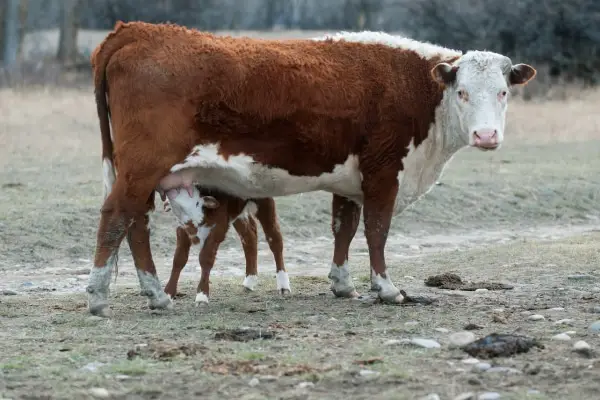
Don’t let their imposing horns fool you – Herefords make wonderful cattle for first-time or smaller-scale farmers thanks to an ultra docile temperament. Originating from England, their popularity expanded thanks to traits like:
- Handleability: Exceptionally mild dispositions, unlikely to become aggressive
- Calving ease: Difficult births are infrequent
- Hardiness: Adapt to varied climates and pasture types
- Longevity: Often remain productive over 10 years
- Maternal instincts: Attentive, protective mothers
Herefords produce lean, tender beef at moderate volumes, occasionally tapped for dairy crossbreeding too. Overall an easy-keeping breed perfect for newcomers.
4. Brown Swiss: The Dairy Queen’s Hardy Helpers
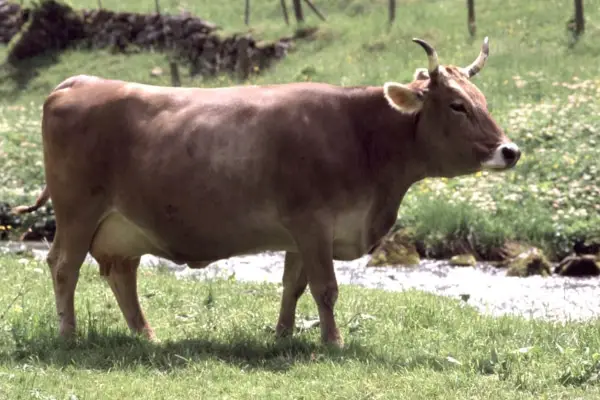
Don’t let the name fool you – Brown Swiss cattle originated amidst the Alps of Switzerland, not Wisconsin! Their distinctive brown hue comes from ultra-dense pigment protecting against sun exposure on high mountain pastures.
Today, Brown Swiss are treasured worldwide among small dairy producers for traits like:
- Grazing ability: Maintains condition on marginal pastures
- Heat/cold tolerance: Withstands temperature extremes
- Disease resistance: Robust health with minimal interventions
- Longevity: Remain productive over many lactations
- Milk quality: High protein and fat content ideal for cheese
For homesteaders seeking dairy animals able to thrive with minimal inputs, Brown Swiss are a top pick. Their extra-rich milk takes a bit more labor to process though!
5. Charolais: Muscular Giants Require Experienced Handling
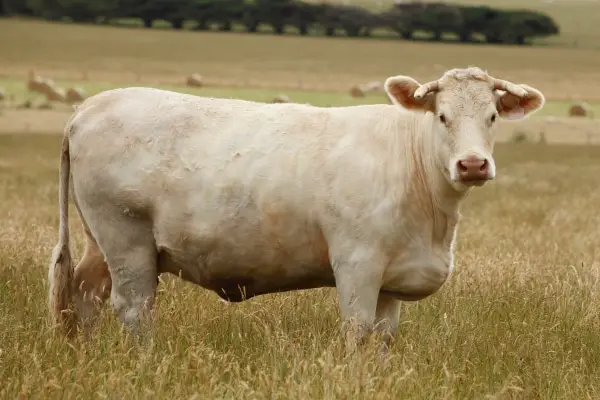
Seeking maximum meat yield from your cattle? Charolais should top your list. These French origin powerhouses are among the largest and fastest growing of breeds. With mighty muscles and lean carcasses, Charolais offer:
- Carcass yield: More pounds of retail cuts from each animal
- Carcass quality: Tender, finely textured lean meat
- Growth rate: Reach finish weight sooner than British breeds
- Feed efficiency: More muscle growth per pound of feed
The main caveat? Charolais temperaments don’t match their physique. Skittish, excitable behaviors require skillful handling best left to veteran cattlemen and women. But for maximizing beef output on sufficient acreage, Charolais dominates.
6. Galloway: Naturally Small and Spirited
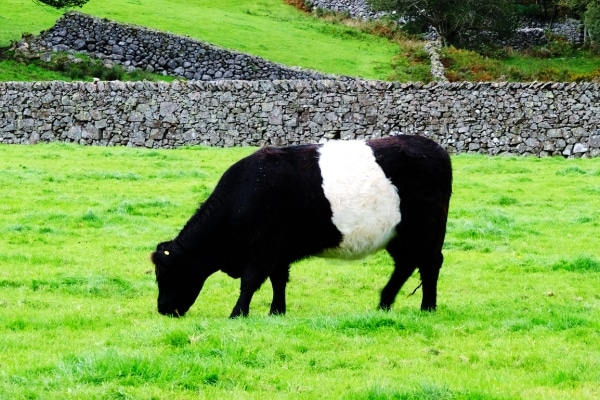
Farms with limited acreage often struggle finding cattle breeds suitably compact for smaller pastures. Enter Galloways – a heritage breed from Scotland bred to thrive on rugged terrain with sparse forage. Naturally petite, they offer:
- Small stature: Mature bulls under 1,000 lbs, cows around 600 lbs
- Low maintenance: Hardy, adapted to marginal grazing
- Calving ease: Unlikely to require birthing assistance
- Mothering skill: Attached to offspring, sheltering them in storms
- Long coat: Double hair layer naturally sheds rain, snow
Galloways produce flavorful, nicely marbled beef consistently higher graded than their small size predicts. And their lively, curious temperaments keep smallholders entertained!
7. Simmental: For Efficient, Large Scale Production
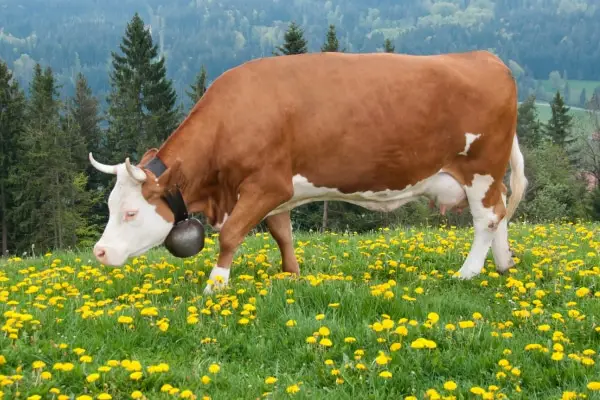
Seeking top efficiency converting feed to milk or meat? Fast growing Simmentals deserve your consideration. Originating from Switzerland’s Simme Valley, they’ve gained global popularity thanks to traits like:
- High milk yield: Over 25 liters daily for peak production
- Weight gain: Rapidly put on pounds as beef cattle
- Udder health: Low rates of mastitis infection
- Birth weights: Strong calving ease for heifers
- Disposition: Typically even, patient temperaments
With good fertility, longevity and versatility too, Simmentals make excellent choices provided your operation’s large enough to support their higher feed intake demands.
8. Milking Shorthorn: Top Notch Dual Producer
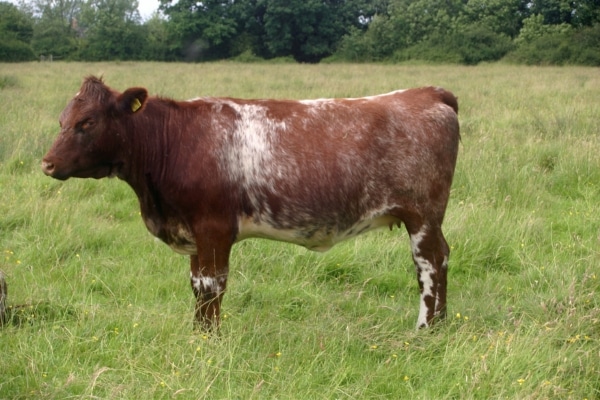
Prefer the idea of a single breed generating both milk money and beef calves? Check out Milking Shorthorns. Originating from northeast England, they were the first registered cattle breed in the US for valued merits like:
- All-purpose utility: Sufficient milk while producing quality beef simultaneously
- Ability to thrive solely on pasture, without grain or other supplements
- Calving ease both for bulls and first-time heifers
- Disposition: Characteristically docile and easily handled
- Weather tolerance: From hot summers to frigid winters
While unable to match pure dairy or beef specialists in single output categories, Shorthorns are the ultimate compromise for diversified family farms.
9. Scottish Highland: World’s Favorite Heritage Breed

Seeking hardy cattle able to forage amidst rocky highland terrain or frigid winters? Put Scottish Highlands on your list! Wildly popular as a heritage breed for small farms, their merits include:
- Ability to thrive on poor quality, marginal forage
- Double coat of hair and insulating undercoat to withstand temperature extremes
- Calm temperaments despite intimidating horns and long hair
- Light birth weights reducing need for calving assistance
- Excellent mothering skills and protective instincts safeguarding calves
For homesteaders seeking easy-care cattle that practically raise themselves while producing deliciously lean grassfed beef, Highlands are a top choice. Their charming, fluffy appearance doesn’t hurt either!
Beyond Breed Selection
With insight now into traits of leading cattle breeds, you’re equipped to narrow options well suited for your farm. A few final considerations remain.
Matching Personalities
Cattle may spend ample time in pastures, but you’ll still be interacting regularly – especially with dairy animals requiring twice daily milking. Ensure you select breeds matching your experience level and personality:
- Beginner/Small Farms: Prioritize calm, docile breeds like Angus, Jersey, Hereford
- Working Full-Time: Need hardy, low maintenance breeds like Galloway, Highland, Dexter
- Agility/Strength: If needing to wrestle cattle solo, moderate frame/weight important
- Intolerance for Heat/Cold: Choose adaptations suiting your climate
Locating Your Breeders
Once you’ve selected one or two breeds, locating reputable breeders with quality stock is essential.
- Check with local agricultural extension resources for breeder referrals
- Search national cattle association databases for breeders in your state
- Attend cattle shows/expos to connect with breeders and see animals firsthand
- Interview breeders carefully on practices, health testing, lineage records, etc
- Request to see the herd in person and assess temperament
Remembering Health Matters
Every breed has certain medical conditions they are prone towards. Discuss common health issues with your chosen breed’s association and vet to remain vigilant. A few top concerns include:
- Calving difficulties – Herefords, Holsteins more susceptible
- Pink eye – Angus and other black hided cattle at higher risk
- Mastitis – Excellent milking hygiene prevents this costly dairy cattle infection
- Bloat – Common issue across breeds requiring emergency intervention
Let the Cattle Quest Commence!
We hope this guide has simplified the complex process of selecting the right cattle breed for your farm! With specialized breeds for every climate and production purpose imaginable, focus on your goals and resources to narrow promising options.
And if feeling overwhelmed as you embark on this new endeavor? Seek mentorship from experienced cattlemen in your area. Their wisdom and guidance as you research breeds and prepare facilities will prove invaluable before making your first cattle purchase.
Soon you’ll have a thriving herd grazing your fields – perhaps a black Angus bull and his daughters producing beautifully marbled beef, or a lively herd of brown Swiss converting your pastures into creamy milk and glistening cheese. Maybe even a dual herd with foals carefully matched to minimize calving issues!
Whatever your dreams for your new farm endeavor hold, may your cattle bring you as much joy, purpose and prosperity as you provide them excellent care. Happy cattle choosing, and happy future farming!


